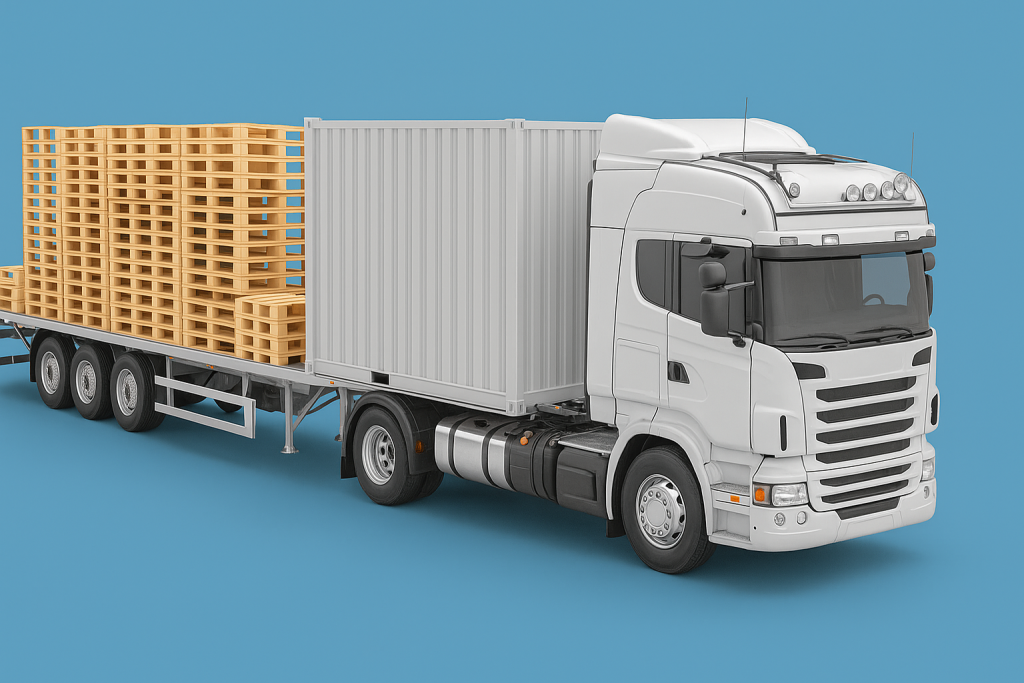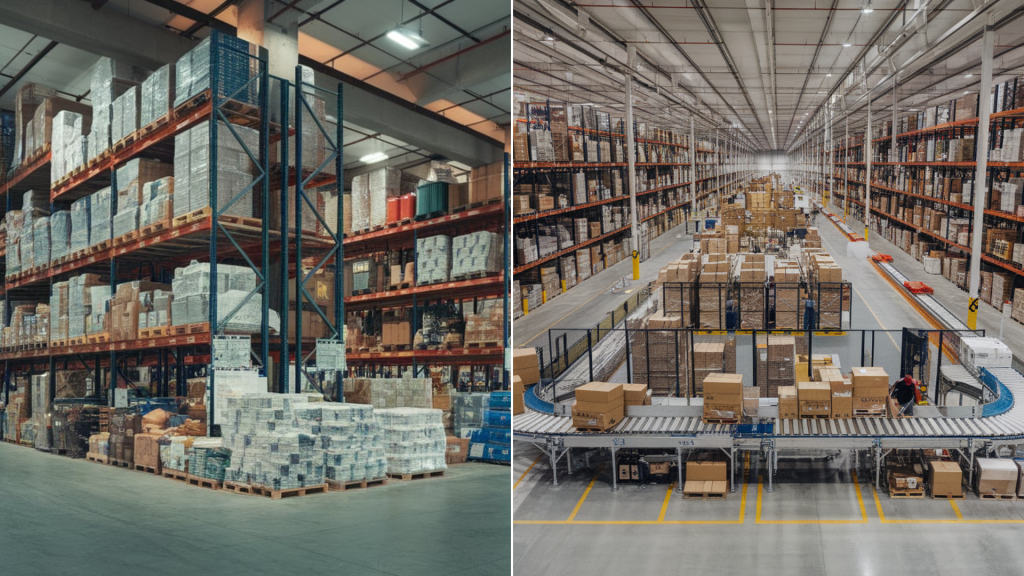If you’ve ever been involved in shipping or warehouse planning, you’ve probably asked yourself: How many pallets fit on a 53-foot trailer?
I’ve found this to be one of the most important questions in logistics because the pallet count directly impacts shipping costs, time efficiency, and overall freight management.
A 53-foot trailer is the most common choice for long-haul trucking, but the exact number of pallets depends on size, loading method, and whether products can be stacked.
In this guide, I’ll walk you through pallet capacity, loading patterns, and comparisons with other truck sizes to help you plan shipments accurately.
What is a 53-Foot Trailer?
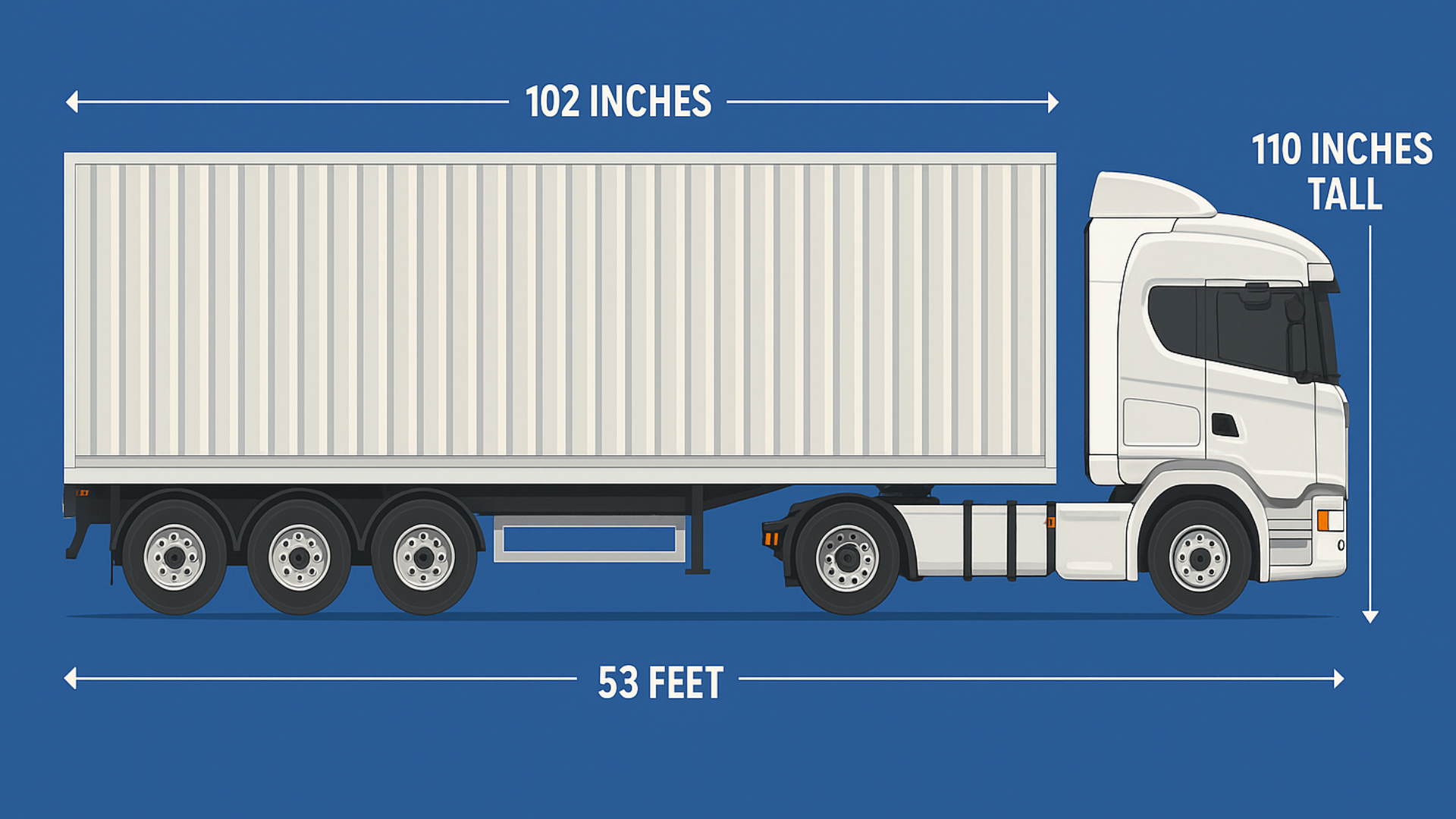
A 53-foot trailer is the most widely used dry van in freight shipping. It measures about 53 feet long, 102 inches wide, and roughly 110 inches tall inside.
These trailers are preferred for large shipments because they can carry a high volume of pallets while still following road regulations.
Beyond size, the 53-foot trailer is valued for its versatility. It can haul different types of goods, from packaged consumer products to industrial materials.
Most trailers are enclosed dry vans, protecting cargo from weather and damage, while others are refrigerated units designed for perishable items.
With a weight capacity of around 45,000 pounds, these trailers offer the right balance of space and legal compliance, making them the backbone of full truckload shipping.
Standard Pallet Sizes Explained
Most freight loads use the GMA pallet, which is 48 inches by 40 inches. This size is the standard in the U.S. and allows for efficient use of trailer space.
Other pallet sizes, like 42×42 or 48×48, can fit, but may reduce the total number you can load. Using uniform pallet sizes makes it easier to maximize space and keep loading safe.
Standardized pallets also simplify stacking methods and reduce wasted space inside a trailer. For logistics planning, knowing pallet dimensions helps calculate how many pallets fit on a 53-foot trailer with greater accuracy.
The information about the common pallet size chart is in the table:
| Pallet Size (inches) | Common Use Case | Notes on Capacity in 53 ft Trailer |
|---|---|---|
| 48 x 40 (GMA) | General goods, retail, food products | Standard size – fits 26–28 pallets single-stacked |
| 42 x 42 | Beverages, dairy, chemicals | Reduces total count slightly due to square shape |
| 48 x 48 | Drums, large containers, bulk items | Fewer pallets fit; often used for heavy loads |
| 40 x 40 | Smaller retail goods, specialty loads | May allow for tighter pinwheel loading |
These pallet dimensions highlight how size and shape directly affect trailer capacity, making it easier to plan loads with accuracy and efficiency.
How Many Pallets Fit on a 53-Foot Trailer?
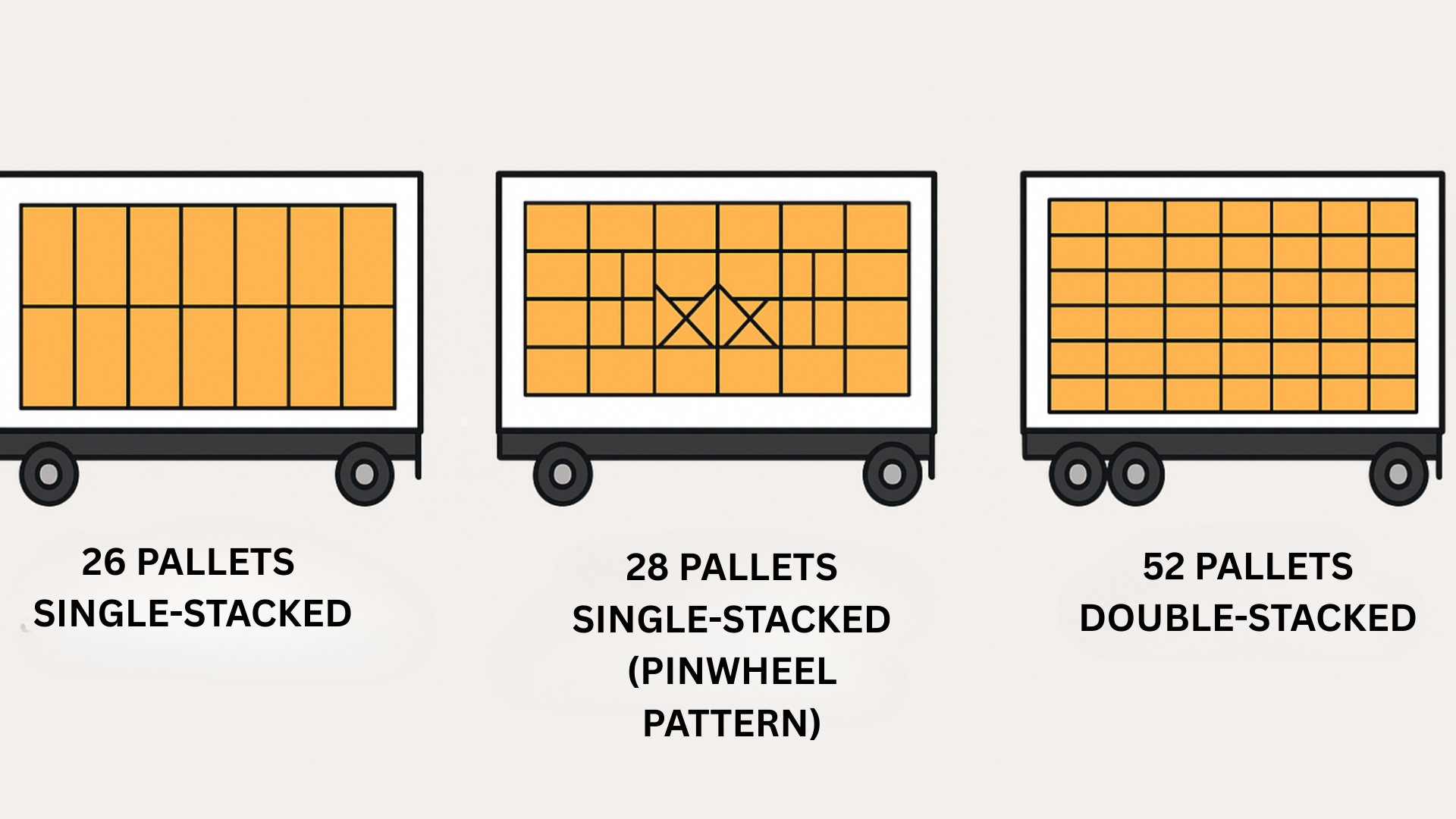
A 53-foot trailer can carry a large volume of freight, but the exact number of pallets depends on how they are loaded. With standard 48×40 pallets:
- 26 pallets single-stacked: This is the most common method, with pallets placed side by side in straight rows. This is the most common method when using standard 48×40 pallets.
- 28 pallets single-stacked (pinwheel pattern): By turning pallets 90 degrees in alternating rows, you can sometimes fit 2 extra pallets, reaching 28 in total.
- 52 pallets double-stacked: Pallets are stacked two-high in the trailer. This doubles the capacity to 52 pallets if the freight is safe to stack.
The 53-foot trailer is considered the best option for full truckload (FTL) shipments because it balances space, weight capacity, and efficiency.
However, factors like pallet size, freight type, and legal weight limits can change the total count.
For example, oversized pallets may reduce the number of rows, while lightweight, stackable goods allow full use of the double-stacking method.
Knowing these numbers is essential for logistics planning, as it helps prevent wasted space, avoid overloading, and ensure safe transportation.
Diagram of 53 Foot Trailer Pallet Loading Patterns
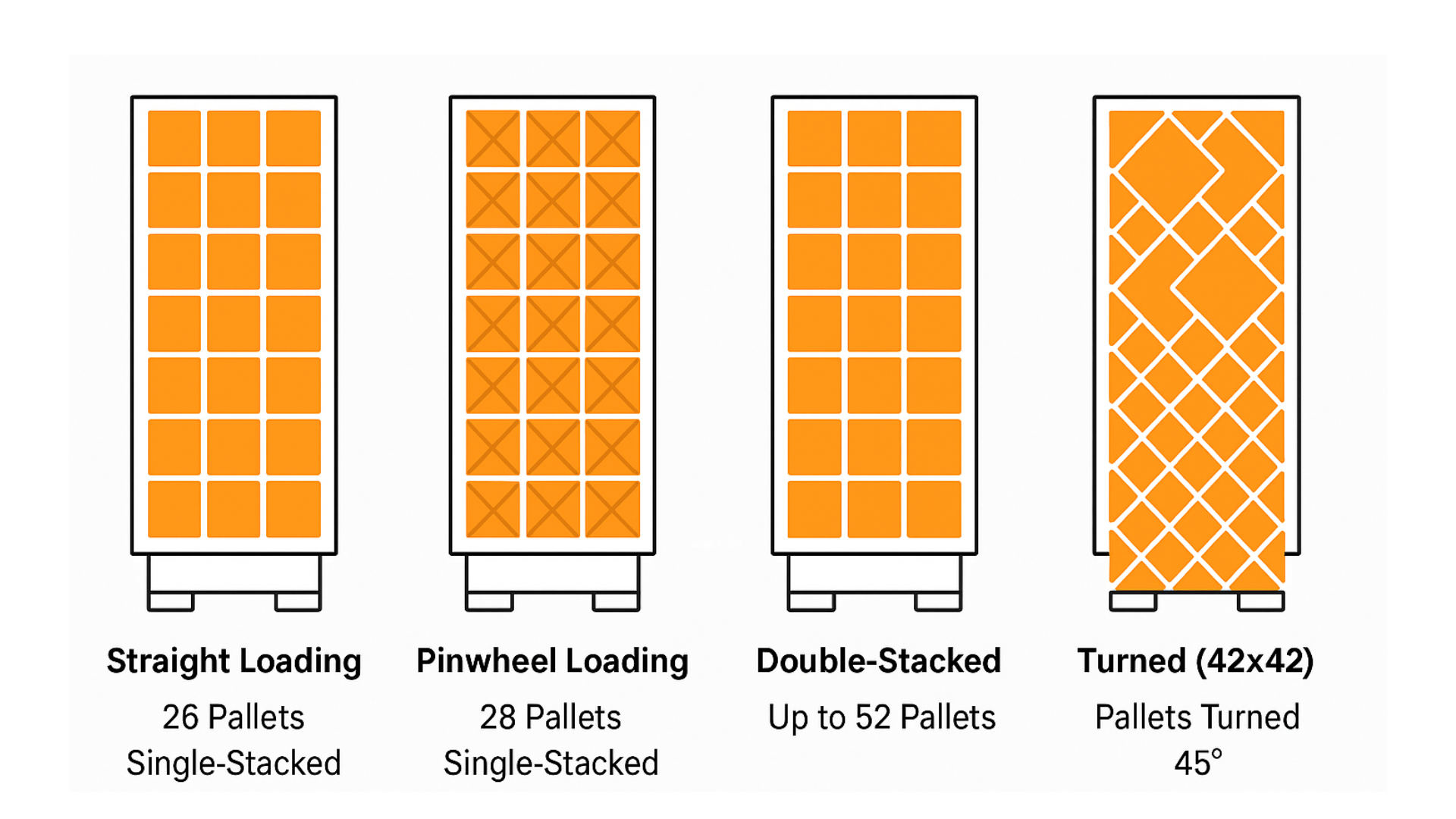
Loading patterns play a big role in how many pallets you can fit inside a 53-foot trailer. Each method affects not only capacity but also weight balance and safety. Below are the main pallet loading patterns:
- Straight Loading: Pallets are placed side by side in straight rows. This is the most common method, fitting 26 pallets single-stacked with standard 48×40 pallets.
- Pinwheel Loading: Pallets are turned 90 degrees in alternating rows. This method can sometimes fit 28 pallets single-stacked, making better use of trailer space.
- Double-Stacked Loading: Pallets are stacked on top of each other, reaching a maximum of 52 pallets if the goods are stable and stacking is safe.
- Turned Loading (Alternate Method): In some cases, pallets are rotated to improve spacing, especially for square pallets (like 42×42). This may slightly increase capacity or improve weight distribution.
A diagram of 53 53-foot trailer pallet loading patterns chart makes these layouts easier to visualize, helping shippers avoid wasted space and plan loads more accurately.
How Many Pallets Fit in Different Trucks?
Not every shipment requires a full 53-foot trailer. Depending on the size of the load, smaller trucks may be a better fit, especially for regional deliveries or less-than-truckload (LTL) freight.
1. 48-foot trailer
A bit shorter than the 53-foot version, this trailer carries 24–26 pallets single-stacked and around 48 double-stacked. It remains common in areas where road rules or infrastructure limit 53-foot use.
Shippers often choose it for regional moves where the slightly smaller size still provides efficiency without wasted space.
2. 26-foot box truck
Often used for retail deliveries and last-mile logistics, a 26-foot box truck can hold 12–14 pallets depending on pallet size and height.
Its smaller size makes it easier to navigate city streets and tighter spaces. This truck is a go-to for regional distribution, store restocking, and short-haul freight.
3. Smaller trucks (20–24 feet)
These trucks fit about 8–12 pallets, depending on dimensions and load height. They are ideal for smaller loads, residential deliveries, and locations where larger trailers cannot fit.
Many businesses use them for multiple-stop routes, local shipping, or cost-effective alternatives to sending half-empty trailers.
Having these numbers on hand helps choose the right vehicle for the job, reduce transportation costs, and improve overall efficiency.
Tips for Efficient Pallet Loading
Loading pallets in the right way saves money, maximizes trailer space, and prevents damage during transit. Some helpful tips include:
- Stick to standard pallet sizes for consistent spacing.
- Use pinwheeling when possible to fit more pallets.
- Balance the weight evenly across the trailer for safe driving.
- Check pallet height before stacking to avoid clearance issues.
- Always secure loads to keep pallets from shifting in transit.
Common Mistakes to Avoid
Even experienced shippers sometimes make errors when loading a trailer. To keep shipments safe and efficient, avoid making these mistakes:
- Mixing different pallet sizes in the same load.
- Ignoring legal weight limits could result in fines.
- Leaving empty space reduces trailer efficiency.
- Forgetting to properly secure pallets can lead to damage.
Conclusion
Understanding how many pallets fit on a 53-foot trailer is essential for anyone handling freight, logistics, or warehouse planning.
The answer is clear: 26 pallets when single-stacked, up to 28 with a pinwheel loading method, and as many as 52 when double-stacked.
While these numbers serve as a reliable guide, actual capacity can vary depending on pallet size, weight restrictions, and the type of goods being shipped.
Using the right loading pattern not only saves space but also ensures safety and efficiency. Now that you know the basics, you’re ready to plan shipments with greater confidence.
Frequently Asked Questions
Do refrigerated trailers hold fewer pallets?
Yes. Due to the added insulation, a reefer trailer has slightly less interior space, resulting in a reduced pallet capacity compared to a dry van.
Can all products be double-stacked?
No. Fragile, irregular, or non-stackable items should not be stacked. Only stable, lightweight goods are safe for double-stacking.
Does weight distribution matter when loading pallets?
Absolutely. Even if pallets fit, improper weight distribution can cause safety issues, fines, or damage to the trailer.
